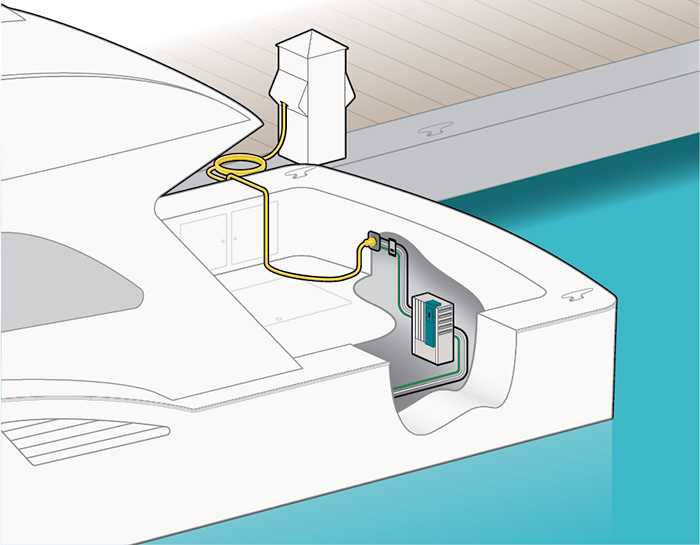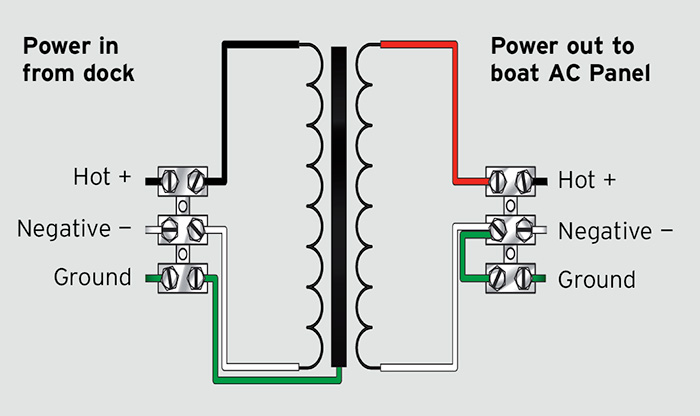Advertisement
Isolation transformers can prevent electric shock drowning, protect underwater metals on your boat, and avoid reverse polarity when plugging into shore power.

Installing an isolation transformer on any boat with a shore power connection prevents galvanic corrosion, reverse polarity issues, and protects swimmers near your boat from electric shock drowning. | Photo: ©2019 Erich Stevens
Water leaking into a boat signifies a problem that'll likely grab your attention pretty quickly. But there's another type of leak that you can't see, but could prove potentially deadly — electricity.
Any boat plugged into shore power has a potential for problems, but these can be largely eliminated thanks to a device called an isolation transformer. With an isolation transformer installed, you can protect your boat from the wasting of underwater metals due to galvanic corrosion, reverse polarity problems, and protect swimmers near your boat from electric shock drowning (ESD). Here's how they work and why you might want to install one.
It Starts With The Green Wire
One of the wires that helps to make your shore power system safe is the green wire, or the grounding conductor. The importance of this wire cannot be understated — it saves lives! The green grounding conductor wire does not normally carry any current, but should there be an electrical fault or short circuit on board, the grounding wire will take the fault current safely back to ground at the source of power. But if this vital green wire is compromised, the stray current will seek to return to its source to complete the circuit by some other route, likely through the water via the boat's underwater metal parts, which can prove fatal to swimmers in the water near the boat.
Even when the green wire works as planned, it's important to understand that every boat plugged into shore power at a marina is electrically connected to one another via the green grounding wire. The unfortunate reality is that it is quite common for low levels of electrical current, both AC and DC, to leak and travel from one boat to another via this green wire. At very low levels (less than 30 milliamps) this can be considered a normal condition. But even without current leakage present, two boats plugged in at the same dock, one with an aluminum outdrive in the water and another with a bronze propeller submerged, are connected via this green wire and make up a perfect galvanic cell — think of it like a giant battery. With both boats connected via the green wire it's more than possible for the aluminum drive to start eroding because it is made of a less noble material than the bronze prop. If there is some way to safely disconnect that green wire, the circuit will be broken and the aluminum drive will be protected. But how can you disconnect this wire to protect your underwater metals and still be safe?
Well, there is one piece of equipment you can install on your boat that will fix all these issues and more: an isolation transformer.

Isolation transformers work by induction. Electricity flowing through one coil creates electricity in the other with no physical connection.
The (Missing) Link
Essentially, an isolation transformer electrically disconnects your boat from shore power. It's installed aboard the boat between the shore power inlet and the boat's main AC distribution panel and works on the well-known principle of magnetic induction. In its most basic form, an isolation transformer is merely two large coils of wire wrapped around iron cores that are rigidly held in close proximity to one another. Running shore power AC voltage through one of the coils creates a strong, pulsating electromagnet near the second coil of wire (see illustration above). This pulsating electromagnetic field induces electric current flow in the transformer's secondary windings, and it is this secondary coil that supplies voltage to the boat's AC panel.
The beauty in this technology is that by using magnetic induction, there is no hard wiring connection between the boat's onboard 120- or 240-volt electrical systems and the dock. The transformer enables removal of one of the components needed to complete the galvanic cell mentioned earlier, a hard-wired connection of two or more dissimilar metals, thus shutting down any voltage migration from the dock side to the boat side of the transformer that can cause your underwater metals to erode. If the secondary side of the transformer is correctly wired, leaking current simply returns to the transformer on the boat via the green grounding conductor, not through the water, which would endanger swimmers. (See "Prevent Electric Shock Drowning" below for more information on ESD.)
In addition, a common dock wiring issue, reverse polarity, is eliminated because the transformer is self-polarizing. If you connect to a dock where the hot and neutral wires are reversed, the transformer doesn't care, and you will still have a good, clean source of AC power aboard.
Prevent Electric Shock Drowning
Most of us know how important the green ground shore power wire is. It carries fault current (electricity that's going somewhere it's not supposed to) back to shore, where it can't hurt anyone.
But marina shore power systems may be less-than-reliable. Due to long-term corrosion or improper installation, the ground wires are sometimes not properly connected, meaning you (and nearby swimmers) are not protected from a fault if the AC shore power shorts into the DC system. This could happen because of a problem in any AC/DC appliance, such as a battery charger. If that happens, any fault current is going to follow a path all through the boat's DC ground and bonding system, which is connected to the engine and underwater fittings, such as thru-hulls and prop shafts.
Because leaking current always searches for a way back to its source (in this case, the marina's shore power system ashore), leaking current will exit the boat and head toward shore. If a swimmer passes through the current, he or she will be electrocuted and may be killed. This is called Electric Shock Drowning (ESD), and every year people die this way. The beauty of an isolation transformer is that because it has taken over duties as the boat's power source, any leaking current will simply return to the transformer on the boat, protecting everyone in the water.
Is It For You?
As much as I would love to see every boat with shore power have an installed isolation transformer for the reasons noted above, reality gets in the way. Isolation transformers are typically heavy, weighing in the 80- to 200-pound range, take up a significant amount of space, get quite hot while running, and can be rather expensive. Bear in mind that if your boat has more than one shore power input, twin 30-amp connections are fairly common, you'll need an isolation transformer for each line, doubling the weight and cost. So they're not for every boat.
That said, if you have a mid- to large-sized boat and regularly connect to shore power, an isolation transformer will enhance your shore power system and onboard safety. Costs range from about $600 on up, plus installation, though the peace of mind may be well worth the price.
